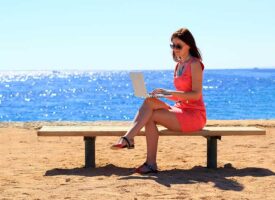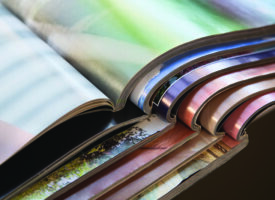
Welcome to the third installment of our new series, Meet the Freelance Writer!
Here, you’ll meet a diverse range of individuals who have carved out a place in the world of full-time freelance writing. You’ll learn all manner of insights about the life of a freelance writer, such as how to start out, what a “typical day” day looks like, and all those other niggling questions we know you have. If you’re curious about freelance writing as a career, or are looking for some advice on how to improve your freelancing business, this is the series for you.
Today, we’ll meet freelance writer Megan Jerrard from the travel blog “Mapping Megan”.
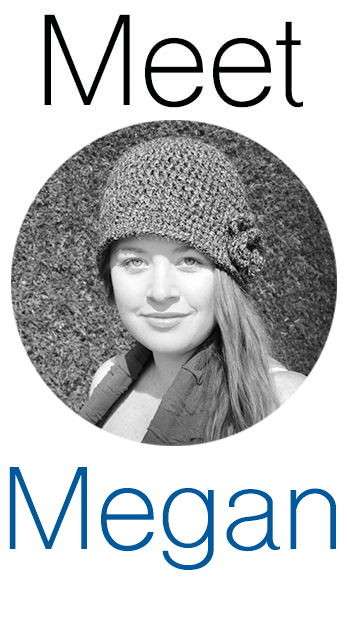 1. Hi Megan! Can you tell us a bit about yourself and your work?
1. Hi Megan! Can you tell us a bit about yourself and your work?
I’m a 28 year old Australian who spends more time traveling abroad than I do in my home country! I have a passion for travel and worldwide exploration, so when I realized that freelance writing and travel blogging was a career path which meant I could work online with the freedom and flexibility of not being tied down to a location, it was a dream come true.
I’ve always had a passion for storytelling, and I completed a journalism degree. When I began traveling in 2007, I started a blog so family and friends could track my movements. It wasn’t until 2013, however, that I realized this platform had the potential to bring in a full-time income. So I put everything I had into transitioning from a hobby blog into an adventure travel brand.
I have been writing in the travel niche ever since; guides, videos, interviews with people we meet on the road, and narratives about our adventures.
2. MappingMegan.com is one of the most widely-read and influential travel blogs on the net. What key steps did you take to cement your blog as an authoritative resource for travelers?
Obviously having quality content is one of the biggest keys to becoming known as an authority within your field, however I’ve always been very aware of the reality that blogging is only 50% content. The other 50% is marketing. Quality content is fabulous, but it doesn’t mean anything if there’s nobody there to read it.
When I began building my brand I applied the “be everywhere” strategy. I became incredibly active on social media, Twitter, Facebook, Youtube, Pinterest, Tumblr, StumbleUpon, Instagram – you name it! And started to network like crazy. I was guest posting for as many other online platforms as I could, taking part in collaborative posts, really pushing my name out there as far as it would go.
Because people need to be able to find you. And in the beginning, you have to position yourself to be found.
3. Can you run us through what your “typical” day may look like when you’re working?
Depending on how I’m feeling I may or may not be wearing pajamas for the majority of my work day! I usually start by clearing my social media notifications and responding to comments on the blog. One of the most important things is engaging with my audience, so I make sure I reply to comments, tweets, and messages at the very start of each day.
Then I jump over to attack my inbox, and my tasks for the day will be based around what’s there. That may mean composing a sponsored post for publication later that day, sending responses to queries for guest posts or advertising requests, liaising with clients about press trips, or if my inbox is empty, reaching out to advertisers to drum up new business for the month.
Tasks which filter in from day to day include things like researching for future articles, mapping out our editorial schedule for the month, scheduling social media posts, editing photos and video, and being active within Facebook forums where bloggers interact and help each other out with support, tips and advice.
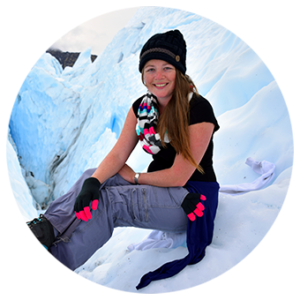
4. After you have selected a new destination to write about, what is involved in the writing and research process?
When it comes to research, we primarily reference other blogs as a starting point to know what to expect. And then after we return, we pull up as many online resources as we can find on the destination to assess where we can provide information which people don’t already know. We try to identify the gaps in information out there so we can provide useful and helpful guides which are unique and stand out from everything else.
In terms of the writing process, I’ve always been more inclined to sit down and pump out a post in one go, as opposed to composing it over a couple of days or weeks. I’ll take notes while I’m on the ground, experiencing the destination, usually via a Dictaphone on my mobile, and this helps as a reference point to bring me back to how a destination felt, tasted and smelled. It helps to recreate what it felt like to be there in the moment.
5. You wrote an interesting blog which detailed how you managed to afford frequently traveling throughout your university years. How do you now fund your travels?
When I began traveling, my number one priority was having the money to afford my trips. So I would work 20 hour days across multiple jobs, while studying full time, to save and pay for everything.
That said, there are so many ways to travel cheaply without having to work such crazy hours. And if you travel full time, as myself and husband Mike did for a while after we married, it’s actually a lot cheaper living on the road that it is to pay the typical costs of a Western lifestyle. Obviously having a location independent lifestyle was central to our ability to continually move around, though working remotely is becoming more and more the norm these days, and many people are now pursuing the “digital nomad” life.
Now, we’re based permanently in Australia, we’re paying those bills associated with a Western lifestyle – rent, electricity etc. However, we are quite fortunate that a lot of our travel is subsidized or comped as a perk of running the blog. My husband Mike has recently set up his own travel blog too, Waking Up Wild, so we hope that in the future we will have two online platforms which are bringing in a steady stream of cash.
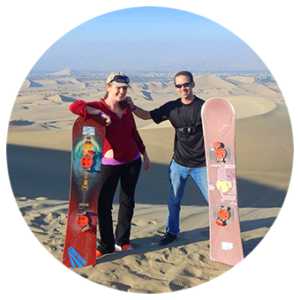
6. Which post on your blog is the most popular? What elements in this blog do you think have helped contribute to its success?
For a very long time, the most popular post on the site was “The Sexiest Male Travelers Alive” – probably because sex sells! It was averaging 8,000 views a day at one point and crashed our site a few times!
That was in 2014 however, and since then views on other posts have overtaken it. “Tips for maintaining a long distance relationship”, “Countries that don’t celebrate Christmas”, these posts are popular because they rank in the top results of Google searches, and bring in a lot of traffic from Search Engine Optimization (SEO).
7. You partner with many different companies, and have been featured by a number of leading publications such as National Geographic. How do you convince clients of the benefits of working with you, or allowing you to contribute to their site?
Establishing a portfolio of work is one of the keys to working with bigger clients. I’ve found it’s been a rolling ball effect. You start at the bottom, and build up a portfolio of your work on your own site, then you start writing for others, whether that be other travel blogs, newspapers, magazines. It’s that same “be everywhere” strategy – the more people see and hear your name, the more they’re going to be likely to want to work with you.
After you have a solid portfolio of work, and a solid reputation where people know who you are and recognize your name, it’s easier to pitch, and in some cases you may find work starts coming to you.
8. You’ve worked remotely in dozens of countries around the world. If you had to name a few countries that are ideal for digital nomads to settle in, where would you pick and why?
Honestly, I think anywhere with a reliable internet connection can be the ideal country for a digital nomad to settle in. Asia is quite a popular region among digital nomads due to its low cost of living, and easy access to a lot of travel opportunities, but then North America is great as they are leading the way in being open to working with bloggers and social media influencers. It really depends where your priorities lie.
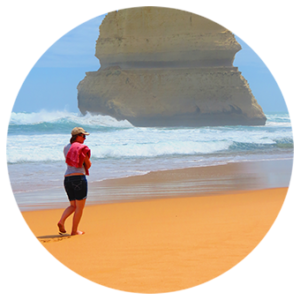
9. Are there any particular SEO tactics you recommend other bloggers to adopt if they want to improve the visibility of their site?
One of the biggest SEO mistakes bloggers and niche site owners make is forgetting to correctly title, caption or optimize their photographs. All too often bloggers upload photographs leaving the title as 453DCM.jpeg, which is horrible SEO practice.
Simply changing the title of your photographs before uploading them will do wonders for your SEO, and mean that your photos are showing up in google image searches under relevant keywords and search terms.
Remember that photos in Google searches are clickable and direct traffic through to your website – by not optimizing your photos and thinking of SEO when you upload them, you are missing out on this traffic. Make sure you also add alternative text and a description when uploading to WordPress.
10. In what ways do you think your Journalism degree has helped the development of your writing? Would you recommend young aspiring writers to enrol in a Journalism course?
My journalism courses have definitely imparted valuable skills when it comes to the development of my research and writing. Having had that background in reporting, I can put a story together very quickly, and grateful for the research skills I learned as I believe I’m quite good at making sense of and finding relevant facts.
My studies were also a great opportunity to build confidence in the art of interviewing, and I’m very comfortable approaching strangers and sitting down for a chat. Our assessments in school were very practical, and would include heading out into the streets to find a story, to conduct vox pop interviews – so I’m very grateful for having had the experience.
You can absolutely be successful at travel blogging and freelance writing without having undertaken higher education, however, I believe my degree was a fantastic chance to learn from experienced professionals, and fine tune my skills.
11. Are there any other travel bloggers whose writing your admire, or look to for inspiration?
Gary Arndt runs Everything Everywhere and was the reason I started blogging. He is a world famous travel photographer, and has a truly fabulous blog.
Hannah Logan runs Eat Sleep Breath Travel and constantly publishes really thought provoking articles and entertaining reads.
Shane Dallas from The Travel Camel documents his travels to some of the most dangerous countries in the world, and destinations others dare not visit, and has a really fascinating blog with fantastic photography from his journeys.
12. Finally, what advice would you give to someone trying to break into full-time travel blogging?
Understand that it’s one of those professions which first requires a large investment of time without return. You’re not going to instantly start making money from a travel blog, and nor are you going to find success overnight. It’s a slow and steady slog to grow your audience to a point where advertisers start wanting to invest, but once you do get there the benefits and rewards are well worth the hard work.
Thanks Megan!
Dream of becoming a full-time #travel #blogger? Find out how in our interview with one of the biggest: https://t.co/Uui4jJDV0E @mappingmegan pic.twitter.com/5084n7LFQE
— Freelance Writing (@FLW_Home) October 6, 2016
– – –
We’d love to hear your opinions about Megan’s interview! Leave a comment below, and keep the conversation going by following us on Facebook and Twitter.
Addicted to our new series? Catch up on the rest of the Meet the Freelance Writer interviews.
Want to be interviewed on Freelance Writing? If you’re a full-time freelance writer who is interested in being one of our featured freelancers, please email a short bio of your freelance writing experiences and a link to your webpage to editor [at] freelancewriting [dot] com
All photos published with full permission from Megan Jerrard.

